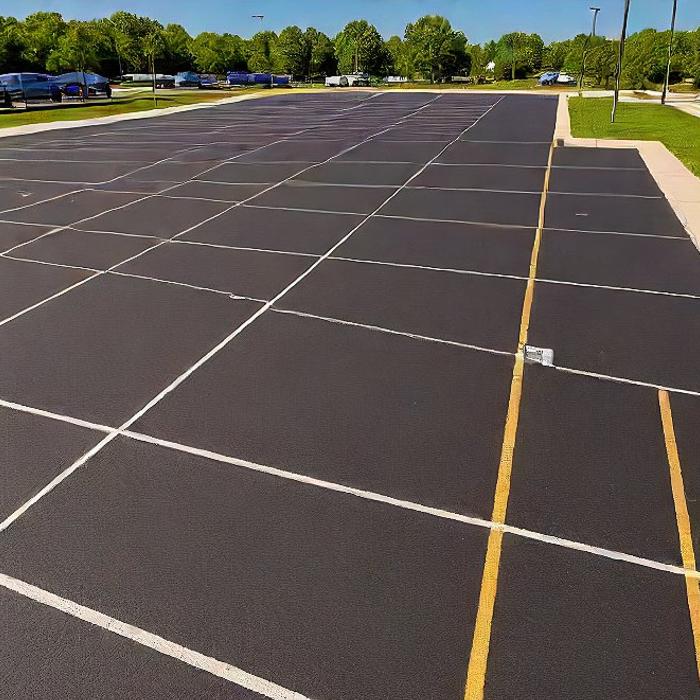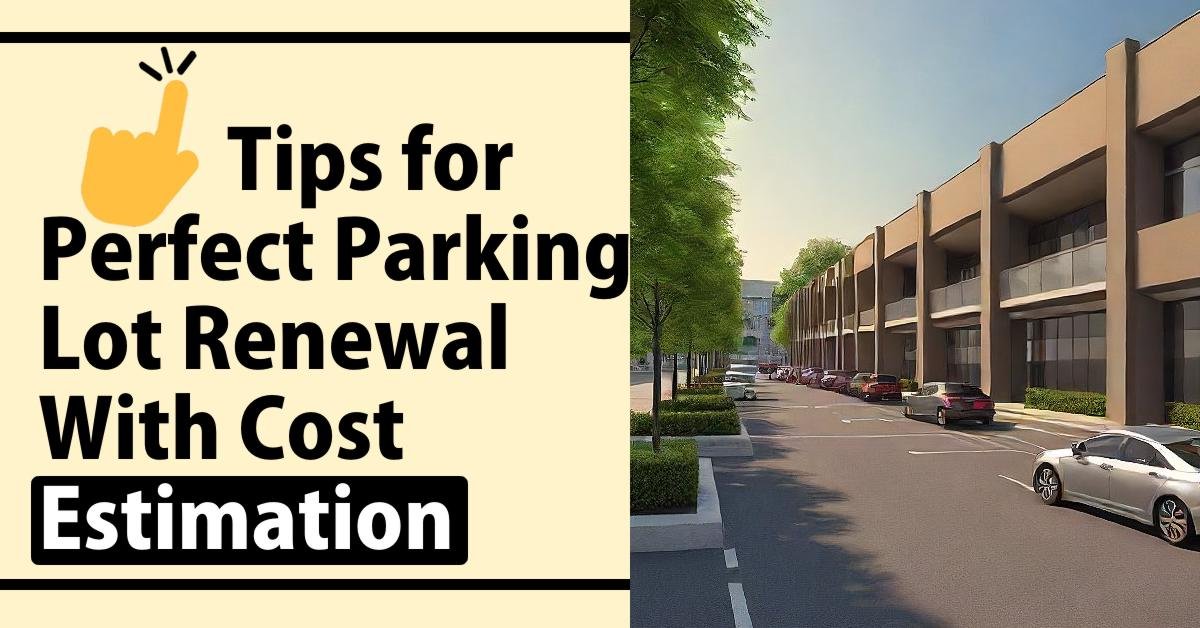Optimize the Functionality and Appearance of Your Parking Facilities
Achieving perfect parking lot renewal requires careful planning and execution. Here are some essential tasks to ensure you get the best results, focusing on the key aspects: ideal look, optimal space, and easy access. Based on my 25+ years in the industry, I have found that the best parking lot rehabs focus on four key areas: drainage, pavement quality, lighting, and pedestrian access.
Simple 7-Step Process for Ideal Parking Lot Rehabilitation
Rehabilitating your parking lot is a major endeavor, but breaking it down into manageable steps makes the process more achievable. Here is an efficient 7-step process I recommend to clients to ensure optimal rehabilitation:
1. Inspect and Identify Problem Areas
Carefully assess current drainage, pavement, lighting, and pedestrian access conditions. Note cracks, crumbling, flooding issues or lack of light posts and crosswalks. This allows you to document rehabilitation requirements and priorities.
2. Improve Drainage
Faulty drainage causes flooding, ice patches in winter, and pavement deterioration. Install catch basins, trenches, upgraded piping and proper grading to keep water flowing out of traffic areas.
3. Repave Lot Surface
Repair cracks, dig out and replace damaged sections, seal coat, and apply fresh striping for a smooth, safe surface. Consider permeable pavement materials to improve drainage.
4. Add or Upgrade Lighting
Proper lighting improves safety and makes navigation easier. Evaluate placement and output of existing lighting, adding new posts or higher output bulbs as needed.
5. Reconfigure Entrances/Exits
Optimize traffic flow for easier access/egress. This also presents a chance to upgrade to speed bumps, signage or gates to better control vehicles.
6. Improve Pedestrian Access
Clearly designated crosswalks, proper curb cuts and connectivity to sidewalks/buildings enhance safety and convenience for pedestrians.
7. Incorporate Landscaping
Trees, shrubs, garden beds, and greenspaces boost aesthetic appeal while providing environmental benefits.
Following this rehab process helps transform parking areas into functional assets with improved safety, appearance, and value. Now let’s explore some best practices and helpful guidelines for key rehabilitation elements.
How to Implement Proper Drainage Systems
The root of many parking lot problems is inadequate drainage, resulting in cracked, uneven pavement and flooding. By upgrading drainage capabilities, you can resolve these problems and extend the usable lifespan. Recommended best practices include:
Conduct Thorough Inspection
Identify all areas where water accumulates and moves across the lot. Check the functionality of existing infrastructure like catch basins, trenches, and piping.
Install Catch Basins
Strategically place new catch basins around the perimeter and between parking aisles. Catch basins collect and divert water into drainage pipes below ground level.
Add Drainage Trenches
Trenches channel excess water away from high-traffic zones. Connect trenches to catch basins or existing drainage pipes.
Repair/Replace Underground Pipes
Clogged, cracked, or undersized pipes cause water backup and flooding. Repair damaged sections or replace pipes completely as needed.
Regrade Surfaces
Reslope surfaces so water flows directly to catch basins. A 2% grade or 2-inch drop over 100 feet is typical.
Proper grading is critical for effective drainage. Use laser-guided equipment to achieve necessary slopes and direct the flow of water appropriately.
By fully upgrading drainage capabilities, you can resolve persistent flooding issues while extending the life of your pavement investment.

Cost of Parking Drainage Repair In Parking Lot Restoration
| Action | Typical Cost Range |
|---|---|
| Catch Basin Installation | $2,500 – $3,500 per basin |
| Drainage Trench Creation | $15 – $30 per linear foot |
| Underground Pipe Repair | $100+ per linear foot |
| Lot Regrading (per 5,000 sq ft) | $1,500 – $4,000 |
Optimize Asphalt Pavement Rehabilitation
Once drainage is addressed, the focus shifts to repairing and improving the parking lot surface itself. Use these asphalt pavement best practices for ideal rehabilitation:
Repair Cracks
Seal minor cracks with an asphalt filler compound. For major cracks, router out damaged sections and apply fresh asphalt.
Remove & Replace Damaged Areas
Dig out badly cracked or settled areas, backfill, and compact substrate, then pave over repairs for an even surface.
Apply Sealcoating Treatment Protect pavement and fill minor cracks/holes with asphalt-based seal coating product. Reapply every 2-4 years.
Restripe Parking Lines
Fresh striping makes spaces clearer and improves traffic flow. Include direction arrows, pedestrian crossings, and handicap spaces.
Consider Permeable Pavement
Allowing water to soak through the pavement into an aggregate base protects the substrate and improves drainage.
Perform Regular Maintenance Ongoing crack filling, seal coating, and line repainting preserves quality and prevents costly repairs later.

Cost Estimation of Asphalt Pavement Renewal
| Pavement Rehab Activity | Typical Price Range |
|---|---|
| Crack Sealing | $0.25 – $1.25 per linear foot |
| Pothole/Damaged Section Removal & Replacement | $6 – $12 per square foot |
| Asphalt Sealcoating (per 5,000 sq ft) | $950 – $2,100 |
| Parking Space Striping | $1 – $3 per linear foot |
| Permeable Pavement Install | $4 – $8 per square foot |
By combining targeted repairs with protective sealants and routine upkeep, you can achieve the smoothest, safest parking area within your budget.
Lighting Replacement Enhances Safety & Aesthetics
Proper lighting is essential for safe, easy navigation in parking facilities. When rehabilitating your lot, evaluate lighting needs with these guidelines:
Conduct Night Safety Audit Observe lighting conditions after dark. Note poorly illuminated areas and shadows where pedestrian visibility is compromised.
Add New Light Posts
Supplement perimeter lights with additional posts between aisles or along pedestrian routes. Space at ≤ 1.5 x mounting height.

Install Higher Output Bulbs If existing fixtures provide insufficient coverage, replace bulbs with higher-lumen LEDs for brighter cast light.
Improve Consistency Use the same lamp color temp (3000K ideal) and output level across all light posts for even coverage without dark patches.
Include Pedestrian Lighting
Illuminate designated pedestrian zones, crossings, and sidewalk connections separately from vehicle aisles.
Control With Photocells/Timers Automated controls ensure lighting activates from dusk to dawn as needed. This saves energy and prolongs lifespan when not required.
Proper parking lot lighting deters crime, prevents accidents, and creates a more inviting environment at comparatively low rehabilitation cost.
Lightening Cost Estimate Per Item
| Lighting Rehab Task | Typical Price Range |
|---|---|
| New Light Post Installation | $300 – $1,500 per post |
| Bulb Replacement | $10 – $40 per bulb |
| Photocell Sensor | $10 – $80 per sensor |
| Timer Switch | $50 – $150 per switch |
Enhancing Pedestrian Access & Safety
Parking lots cater primarily to vehicles, but integrating pedestrian amenities through rehabilitation improves convenience and safety. Ideal features include:
Designate Crosswalk Zones
Paint highly visible striped crossing areas connecting parking sections to buildings. Signage further identifies right-of-way.
Add Speed Bumps Before Crossings
Moderate vehicle speeds for safer pedestrian crossing. Flexible rubber models provide sufficient slowing without damage risk.
Install Curbed Medians If Needed
Curbed medians or barricades offer added pedestrian protection mid-crossing if multiple lanes must be traversed.
Upgrade Curb Cuts
Angled curb cuts with textured concrete allow smooth wheelchair access between parking and sidewalks/buildings.
Connect Sidewalks
Continuous interior sidewalks should lead to perimeter walkways and public sidewalks around the lot’s borders.
Creating clear navigation paths and protective measures tailored for pedestrians makes your rehabilitated parking facility more welcoming and accessible.
Incorporate Landscaping to Boost Curb Appeal & Eco-Benefits
Finally, interspersing landscaped green spaces throughout parking areas adds aesthetic appeal while providing meaningful environmental benefits like cleaner air, reduced storm runoff, and cooler summertime temperatures.
When rehabilitating a tired, unsightly parking lot, take the opportunity to add WiFi-managed landscape lighting and consider locations for:
- Trees & Shrubs: Provide cooling shade and clean the air. Cluster native, low-maintenance varieties near pedestrian zones.
- Rain Gardens: Attractive, low-lying beds with water-tolerant plants filter and absorb runoff. Position near catch basins or drainage routes.
- Bioswales: Shallow, vegetated trenches slow and filter water flow to drainage systems while adding visual interest.
- Green Medians: Long center islands filled with low grass, flowers, or bushes break up vast paved areas.
Tasteful landscaping gives new life to worn parking facilities. The environmental benefits also support property value by meeting sustainability goals. Even modest green additions make a substantive visual impact.
